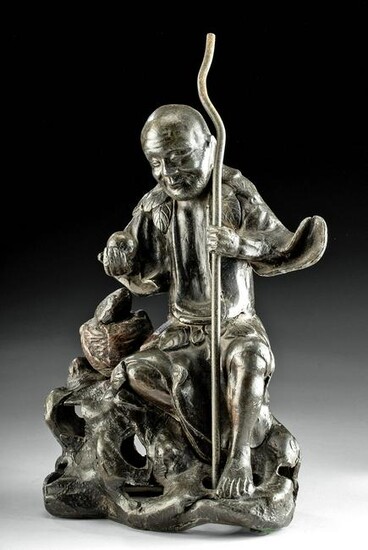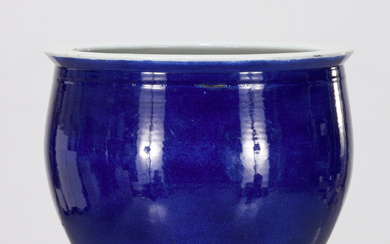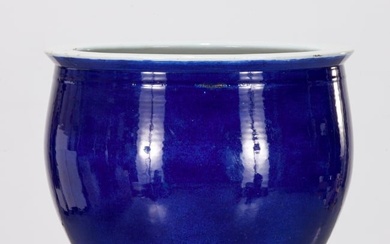18th C. Chinese Qing Seated Figure in Lead
**Originally Listed At $1500**
East Asia, China, Qing Dynasty, ca. late 18th to early 19th century CE. A charming hollow lead statue of an intricately detailed seated man next to a basket of fish expertly cast via the lost wax (cire perdue) process and presenting in a dark taupe hue. Holding a walking stick in his left hand as his flared sleeve gracefully blows in the wind, the sage-like figure looks down jovially at an orb-shaped object, perhaps an apple or another spherical fruit, held in his right hand. His round visage features a long wrinkled forehead, two heavy-lidded almond-shaped eyes adorned with crow's feet, a wide flat nose, prominent cheekbones, full lips fixed in a small grin flanked by dimples, and some heavy stubble, on its way to becoming a beard. His long straight hair falls onto the top of his back, as large leaves adorn his shoulders and his robe, which hangs open and exposes his chest, is tied at his waist with a string of additional sizable foliage. A small woven basket with the head of a fish poking out is placed to his right, implying that he has stopped for a meal. Size: 5.25" W x 8.875" H (13.3 cm x 22.5 cm)
His leafy outfit and basket of fish indicate that he may be Fuxi, the first male ancestor of Chinese mythology and inventor of fishing, hunting, cooking, writing, and the domestication of livestock. Though usually depicted with the body of a snake accompanied by his sister, Nuwa, he is sometimes shown as a lone sage-like man, such as in a woodcut entitled "The Emperor Fuxi" by Gan Bozong (Tang period 618 to 907) in the Wellcome Collection, London (ID number: L0039312).
Provenance: private Newport Beach, California, USA Collection
All items legal to buy/sell under U.S. Statute covering cultural patrimony Code 2600, CHAPTER 14, and are guaranteed to be as described or your money back.
A Certificate of Authenticity will accompany all winning bids.
PLEASE NOTE: Due to recent increases of shipments being seized by Australian & German customs (even for items with pre-UNESCO provenance), we will no longer ship most antiquities and ancient Chinese art to Australia & Germany. For categories of items that are acceptable to ship to Australia or Germany, please contact us directly or work with your local customs brokerage firm.
#148620
Condition Report: Walking stick is removable. Expected surface wear with some light scratches throughout, nicks/chips to edges of sleeves and left ear, and minor perforations on lap and back. Nice remains of red paint on lap of figure, seat, and basket. Otherwise, excellent with lovely patina.
View it on
Estimate
Time, Location
Auction House
**Originally Listed At $1500**
East Asia, China, Qing Dynasty, ca. late 18th to early 19th century CE. A charming hollow lead statue of an intricately detailed seated man next to a basket of fish expertly cast via the lost wax (cire perdue) process and presenting in a dark taupe hue. Holding a walking stick in his left hand as his flared sleeve gracefully blows in the wind, the sage-like figure looks down jovially at an orb-shaped object, perhaps an apple or another spherical fruit, held in his right hand. His round visage features a long wrinkled forehead, two heavy-lidded almond-shaped eyes adorned with crow's feet, a wide flat nose, prominent cheekbones, full lips fixed in a small grin flanked by dimples, and some heavy stubble, on its way to becoming a beard. His long straight hair falls onto the top of his back, as large leaves adorn his shoulders and his robe, which hangs open and exposes his chest, is tied at his waist with a string of additional sizable foliage. A small woven basket with the head of a fish poking out is placed to his right, implying that he has stopped for a meal. Size: 5.25" W x 8.875" H (13.3 cm x 22.5 cm)
His leafy outfit and basket of fish indicate that he may be Fuxi, the first male ancestor of Chinese mythology and inventor of fishing, hunting, cooking, writing, and the domestication of livestock. Though usually depicted with the body of a snake accompanied by his sister, Nuwa, he is sometimes shown as a lone sage-like man, such as in a woodcut entitled "The Emperor Fuxi" by Gan Bozong (Tang period 618 to 907) in the Wellcome Collection, London (ID number: L0039312).
Provenance: private Newport Beach, California, USA Collection
All items legal to buy/sell under U.S. Statute covering cultural patrimony Code 2600, CHAPTER 14, and are guaranteed to be as described or your money back.
A Certificate of Authenticity will accompany all winning bids.
PLEASE NOTE: Due to recent increases of shipments being seized by Australian & German customs (even for items with pre-UNESCO provenance), we will no longer ship most antiquities and ancient Chinese art to Australia & Germany. For categories of items that are acceptable to ship to Australia or Germany, please contact us directly or work with your local customs brokerage firm.
#148620
Condition Report: Walking stick is removable. Expected surface wear with some light scratches throughout, nicks/chips to edges of sleeves and left ear, and minor perforations on lap and back. Nice remains of red paint on lap of figure, seat, and basket. Otherwise, excellent with lovely patina.







